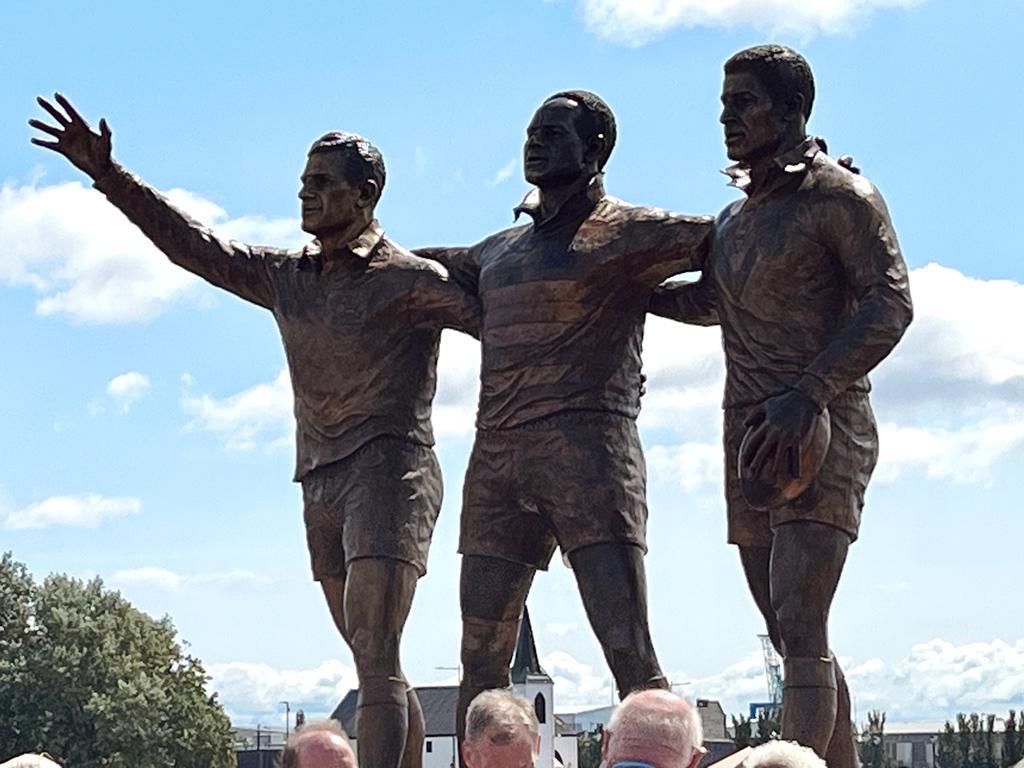
Despite many attempts over the years, top-level rugby league has stubbornly refused to become established in South Wales. But there is finally a fitting tribute to some of the great players it has given the sport, writes Andy Weltch.
A statue celebrating three of Cardiff’s legendary ‘Rugby Codebreakers’ was unveiled in Cardiff Bay this week (19 July 2023). And, incredibly, it’s the first statue in Wales ever to feature non-fictionalised, named black men.
Designed by sculptor Steve Winterburn, the statue immortalises three of Wales’s greatest sporting heroes, chosen by a public vote: Billy Boston, Clive Sullivan, and Gus Risman.
Chairman of the One Team. One Race: Honouring the Cardiff Bay Rugby Codebreakers project, Sir Stanley Thomas OBE, said: “I am delighted after just two years of campaigning and raising funds, we as a committee have reached our fundraising target and we are all here today with Billy, the families of all players, donors and local community unveiling this magnificent piece of art by Steve Winterburn that recognises these wonderful sporting legends in their home city of Cardiff.”
Cardiff Council Leader, Huw Thomas, said: “To have a statue of these incredible players at the heart of Cardiff Bay, in touching distance of the proud multi-cultural communities where they grew up, will serve as a source of inspiration for generations to come. Their achievements have been overlooked for too long, and I’m delighted that today, they are finally being honoured and celebrated in the city of their birth. I’m grateful to all who’ve helped make it happen”
Billy Boston
Born on 6 August, 1934 in Angelina Street, Billy played rugby union for Cardiff Schools, Cardiff and District Rugby Union, Boys Clubs of Wales, Wales Youth, the CIACS and Neath.
While still a teenager, he signed for Wigan RL for £3,000. He went on to score 478 tries in 487 matches for them, helping them to win the six Challenge Cup finals they reached in his 15 seasons at the club.
Billy also scored twice in Wigan’s 1960 Championship final victory to earn them their first title in eight years, and picked up two Lancashire League and one Lancashire Cup winners medals.
Internationally, he won the World Cup with Great Britain and played 31 times for the Lions, becoming their first black tourist in Australia.
Billy is in the Rugby League and Wigan Halls of Fame, on the Welsh Sports Hall of Fame’s ‘Roll of Honour’ and was made MBE for his services to sport. He also has a statue dedicated to him at Wigan and is included on the Rugby League statue at Wembley Stadium.
Clive Sullivan
Born in Splott on 9 April, 1943, Clive became the first black captain of any Great Britain sports team and led his country to the 1972 Rugby League World Cup title, scoring a try in each of their four games in the tournament, including a length-of-the-field effort against Australia that earned a 10-10 draw to clinch the trophy.
He joined the Army from school and had rugby league trials in his late teens. He eventually joined Hull and went on to play 352 games for the club, scoring 250 tries. He later switched to Hull Kingston Rovers and added 118 tries in 213 games. He won the Challenge Cup with both clubs.
In 1966-67 he made his full Great Britain debut, marking the first of his 17 caps by scoring the winning try against France in the last minute. He also featured in the 1968 World Cup series in Australia and captained Wales at the 1975 World Cup.
In 1974 he was honoured with an MBE and he is on the Welsh Sports Hall of Fame ‘Roll of Honour’. The main road into Hull was named ‘Clive Sullivan Way’ in his honour after his death in 1985, aged just 42.
Gus Risman
The son of Russian immigrants who settled in Tiger Bay, Gus was born on 23 March, 1911, in Sophia Street. His parents ran a boarding house and then moved to Barry to run a cafe when Gus was 11. He became one of the greatest rugby players produced by Wales, captaining the rugby union team in War Time internationals despite being a rugby league legend.
His rugby league career statistics are staggering and he is a member of the Rugby League and Workington Halls of Fame as well as being on the Welsh Sports Hall of Fame ‘Roll of Honour’. He already has a street named after him in Salford and Workington and is on the Rugby League statue at Wembley Stadium.
Between 1929 and 1954 he scored 4,052 points in 873 games for Salford and Workington Town. He also played in 36 Test matches for Great Britain, playing in five Ashes winning series, and won 18 Welsh caps.
He won four Rugby League Championships, went to Wembley for the Challenge Cup final three times, picked up five Lancashire League titles and three Lancashire Cup winners medals. He was captain of the Workington Town team that won the Challenge Cup at 41. He died in 1994, aged 83.

Pingback: Rugby ‘codebreakers’ statue wins award | Weltchmedia's Blog